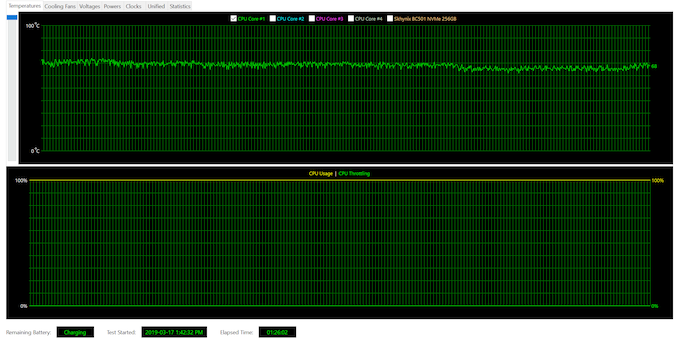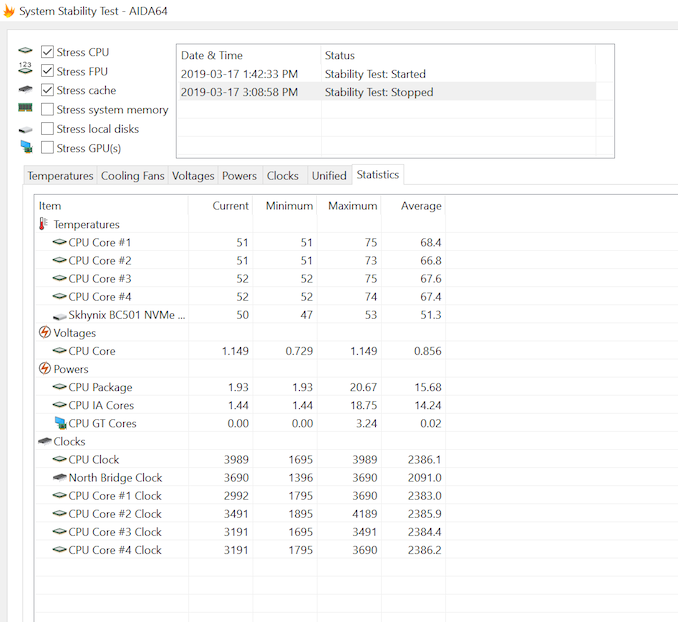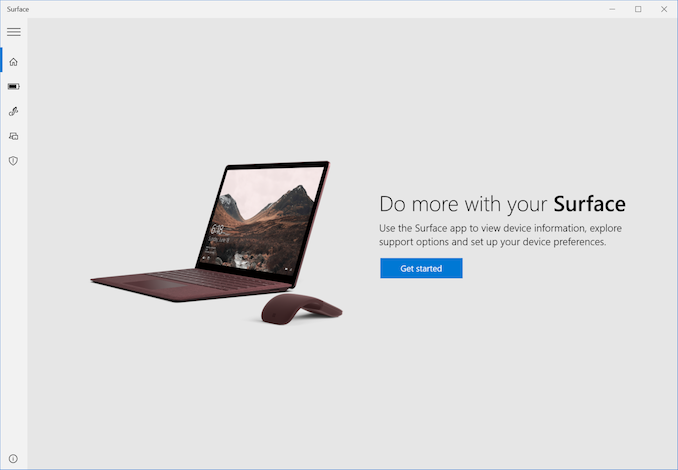The Microsoft Surface Laptop 2 Review: Surface Essentials
by Brett Howse on March 28, 2019 8:00 AM EST- Posted in
- Laptops
- Microsoft
- Surface
- Surface Laptop
- KBL-R
- Surface Laptop 2
Wireless
Everyone talks about the lack of USB-C on Surface, but the really strange question is why does Microsoft still rely so heavily on Marvell for their wireless solutions? Laptop wireless has very nearly become a one-horse game, with Intel being the only major player who continues to update their products annually. As such, the Marvell AVASTAR in the Surface Laptop 2 is just more and more out of date. It was never a great solution to start with, so it’s very odd that they continue to use it all these years later.

Intel’s latest 9260 card is really the wireless adapter to beat in the PC space, offering 160 Mhz channel support, MU-MIMO, and the industry’s best drivers. The good news for Microsoft is that the Marvell solutions have been getting more reliable with some driver updates, but they just don’t offer the level of performance or reliability.
Audio
Microsoft offers an interesting approach to audio in the laptop by placing the speakers underneath the keyboard deck. They refer to this as Omnisonic Speakers, and the result is a win for Surface. You can detect a change in pitch if you put your hands right over the keyboard, but under normal typing there isn’t any noticeable reduction in audio. As a thin and light laptop, don’t expect great things in terms of dynamic range, but at 100% volume the speakers are loud and crisp. Maximum SPL recorded was about 82.3 dB(A) measured one inch over the trackpad.
Thermals
The bane of any thin and light laptop is dissipating heat, so the Surface Laptop 2 was run at 100% CPU load for over an hour to see how it could cope. The Core i7-8650U has a nominal TDP of 15 Watts, although thanks to SpeedShift, on short workloads it can ramp up to over 30 Watts in some devices. In this case, Microsoft seems to have set the PL2 level to about 20 Watts.
We ran the Surface Laptop 2 on a stress test at 100% load for over an hour to see if the device would throttle over time. The answer there is no. Over the hour, the system was able to get rid of enough heat that the temperatures on the CPU never got very high at all. The average temperature over the hour was about 68°C for the duration, and CPU power was right around the 15 Watt level. Maximum power draw was 20.67 Watts right at the start of the test, until the PL2 limit was reached and the device moved into its long-term PL1 load.
The laptop fan never got very loud either, coming in right around 43-44 dB(A) measured one inch of the trackpad, and the Surface Laptop never got too warm to the touch. There’s enough cooling to get the job done without making too much noise.
Software
As a Surface device, Microsoft ships a clean image, or as clean as Windows is these days anyway. The real change here compared to the original Surface Laptop is that Microsoft no longer ships their laptop with Windows 10 S, since the S is now just a feature of Windows. That means you don’t have to unlock all the features anymore, which is good.
The idea behind Windows 10 S was noble. For those not sure what Windows 10 S was, it was a version of Windows 10 that only allowed applications to be installed from the Windows Store. The security benefits here are real, so you can see why they’d want to offer this, but the company has made the right decision in just allowing an S-Mode in Windows 10 itself.
The reality of Windows computing though is that the Windows Store doesn’t offer everything you need, so installing programs is a necessity, so this change is very much welcome. You can get the Surface Laptop with either Windows 10 Home or Pro.













59 Comments
View All Comments
sorten - Thursday, March 28, 2019 - link
If I absolutely needed a laptop today I'd probably pick up a used one so I could wait for the Ice Lake CPUs from Intel this fall. It would be a shame to buy such nice hardware only to find yourself two significant generations behind within 6 months.yankeeDDL - Thursday, March 28, 2019 - link
I hope you're right. Intel has been caught sleeping, and the improvements since SkyLake have been, frankly, anecdotal. It seems that AMD, by making a small core, designed from the ground up to work in tandem with other cores, has a much more effective/scalable architecture. So a 4-core, 8-thread CPU from AMD, while providing slightly lower IPC, today, is much more effective than a 4-core, 8-thread CPU from Intel.Let's see if ICL brings real benefits. The 10nm node should help a lot.
smilingcrow - Thursday, March 28, 2019 - link
"So a 4-core, 8-thread CPU from AMD, while providing slightly lower IPC, today, is much more effective than a 4-core, 8-thread CPU from Intel."I thought AMD currently has lower IPC + lower clock speeds so how exactly are they more effective?
With Ryzen3/Zen 2 due in the summer this may change but for now AMDs advantage is more cores per buck.
niva - Thursday, March 28, 2019 - link
I'm assuming he meant in terms of price/core, but that's just a guess.Doesn't AMD have a big problem with power consumption in mobile CPUs though? I've read that the AMD laptops out now suffer from big power drain even if performance wise they're equivalent or batter than the Intel chips at the same price range.
Irata - Friday, March 29, 2019 - link
Supposedly in idle only, but I do not really see that on my Matebook. Then again, I do not let it sit idling for hours on battery since it boots so quickly that there is no reason for that.In normal use (web / video), the battery indicator does not move much at all.
What many forget is that even with Intel based laptops, there are sometimes big differences between models or manufacturer, depending on the battery size and how well they configured their laptop. The ones that aren't well done are not the ones you usually see in comparison tests though (as there are more models to pick from vs. AMD based ones).
lightningz71 - Monday, April 1, 2019 - link
Their big problem was definitely low power states management on the 2X00u series of chips. The 3x00 series chips that are now hitting the market make up a lot of ground in that regard, both with the chips themselves and better bios/uefi implementations by the vendors that are building the systems. Add in the fact that AMD has finally decided to take the lead on providing a stable, performant drivers for the video section of the chips, and you can largely ignore the abysmal efforts of the vendors themselves to provide quality, updated drivers themselves.For the money, some of the low end AMD 2x00u series laptops gave you MUCH more bang for your buck than the equivalent intel based offerings. The few limitations that people who purchased them did come across could be overcome through software tools by those that it actually mattered to (power and performance management profiles could be tweaked by certain software tools that allowed systems to maintain higher boost states longer and better manage their thermals).
I can't wait to see some of the more thorough write-ups on the latest 3x00h series laptops that are fast enough in both core performance and graphics performance to go up against comparable intel based machines that also include an Nvidia MX1xx series dGPU with an i5. They should technically be less expensive, offer similar performance and be more power friendly when pushed to their limits. This isn't to say that they won't have their flaws, just that, dollar for dollar, on the low end, you'll get more with the AMD system.
Manch - Friday, March 29, 2019 - link
Superior SMTsmilingcrow - Friday, March 29, 2019 - link
IPC includes the whole chip performance so they are still behind.Zen currently makes sense to me if you want 8 or more cores so hopefully with Zen 2 they will compete from 4 cores upwards.
Manch - Monday, April 1, 2019 - link
IPC refers to the perf of a single core usually. Generally has an advantage of about 8-10%. That advantage disapears when using SMT/HT. AMD has the more efficient design so it makes up for that 10% deficit. Throw in multiple core and it starts to win. TBS even now a lot of software is optimized still for Intel but thats changing rapidly. Intel still has a clockspeed advantage. Where as Zen has a pretty hard wall @4.3, Intel can get on down the road a good bit faster. Especially with 4 core chips. I dont think that advantage will last too much longer. Between the mitigations from ME/SPec, and lack of new architecture, Intel seem to be pushing cores over HT now to keep its advantage short term. AMD put out a competitive chip, Intel has yet to fire back like it did with Core against Athlon XPs(Those were the days!) Theyre just stretching their long in the tooth Core. Something is waiting in the wings though.smilingcrow - Monday, April 1, 2019 - link
From what I've seen a 6C/12T Intel beats a similar spec AMD easily.I've read that AMD's HT gives a bigger boost than Intel's but that still isn't enough for it to catch up due to it being too far behind in other areas.
So it's about as meaningful in the real world as a purely synthetic benchmark.
That should change soon with Zen 2 so there will be no need to live the life of a fantasist then.